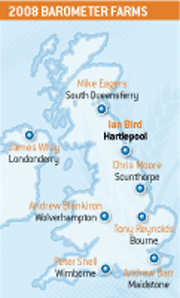New Northern Barometer Farm

The decision to make Farmers Weekly’s new northern Barometer farm in County Durham all-arable, was taken over 25 years ago, Andrew Blake learns
Farming the cold wet land dotted with former collieries and mining villages near Hartlepool has never been easy, says Ian Bird, who runs 1255ha (3100 acres) from Catchgate Farm, Castle Eden four miles from the North Sea.
“It’s hardly the Garden of Eden. We regularly get sea frets at harvest when we can’t cut anything for 10 days.”
Only about 120ha (300 acres) is relatively light soil over limestone. The rest is medium to heavy clay. “When that dries out it sets like bell metal.”
On the plus side the land is well drained. “We’ve spent a lot on drainage.”
Mr Bird left school in 1976 at 16 with no agricultural qualifications. His family had farmed in the area since the 1940s, mainly with livestock, and in 1983 bought Catchgate.
“But it’s surrounded by houses, so it was never a good stock farm. A year later, during the miners’ strike, the whole of our perimeter fence disappeared.
“So we decided to pull the plug and go all-arable.”

Now with only one full-time operator, Paul Summerbell, plus harvest help he farms 445ha (1100 acres), half-owned/half-rented, and has five-year contracts on the rest.
“It’s all in four blocks within a five-mile radius.” Even so road traffic makes moving his large-scale machinery increasingly tricky.
The land is unsuited to spring cropping, though beans have been grown when autumn drilling was closed early by bad weather.
“It’s good winter wheat land if you catch it right,” says Mr Bird. “Our average yield, including second and third crops, is 3.9t/acre. I try to keep it simple with blocks of oilseed rape, wheat and winter barley.
“We must start drilling rape here by 15 Augustsowing it after wheat just isn’t on. We also like to start wheat by 1 September and have all the first crops in by 10 October.”
Easing that exercise was his move, seven years ago, to minimum tillage on about 70% of the land. “We still have to plough wheat land going into barley.”
The current system is based on a 3m Simba Solo, followed by a Simba Cultipress if needs be, ahead of a 6m Simba Horsch drill pulled by a Case Magnum 310. The other main tractor is a Claas 836.
24m 2000–litre Gem sprayer mounted on a Fastrac 2135, backed by an 11,000–litre bowser, applies all the pesticides.
Fertiliser applications, all solid, are via an Amazone ZAM twin–disc machine.
This season’s wheat varieties are Claire,Gladiator,Einsteinand Oakley, the rape Excaliburand Ovation, with barleys Retrieverand Saffron. “We also have some Bronxhybrid barley which looks very well,” he notes.
Although the land has blackgrass, the main weed problem is brome which is not confined to the headlands, Mr Bird admits.
“We’re having to hit it hard with Atlantis, especially where we don’t get a good green-bridge kill.”
Agronomy advice comes mainly from David Coates of CSC Crop Protection which supplies all his spray chemicals, Frontier’s Andrew Roy looking after about a quarter of the crops.
“I’ve looked at the ‘independent’ route but couldn’t really see any benefits.”
The farm has an 11t/hr Allmet drier, but only 2500t of flat–floor storage. So all the barley and rape is sold off the combine, with wheat marketed via Frontier’s John Speed.
“I have a good relationship with him and I decide when to sell based on his advice,” says Mr Bird. “I don’t use options or pools.”
As most of the straw is sold, the farm’s Lexion 480 combine has been replaced by a four-year–old 30ft cut New Holland CX880. “The rotary was causing us problems with straw quality,” he says.
ELS anxiety
DEFRA’s decision to drop management plans as ELS points contributors has angered Mr Bird and left him unsure of the future.
“We’ve never had land in set-aside. We’ve always grown industrial crops.
“So when ELS first came in we didn’t bother with it. But eventually we decided we had to go for it even though we don’t have many hedges and our fields are quite big.”
With FWAG advice, about 8ha (20 acres) of 6m headlands and odd corners were sown to ELS covers.
“Our plan was accepted in July. But now that we don’t get points for management plans, we’re 1200 short of what we need.”
Catchgate Farm
- 445ha + contracting
- Mainly heavy clay land
- Simple autumn-sown rotation – Winter wheat: Winter oilseed rape: Winter barley
- Three-quarters min-tilled

